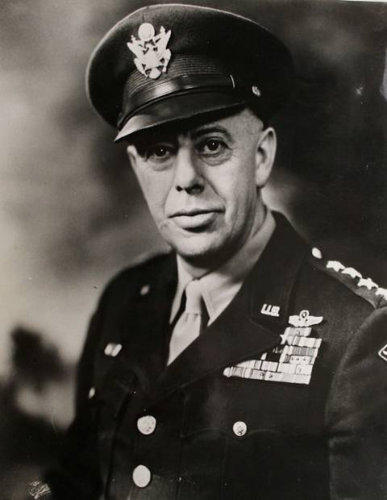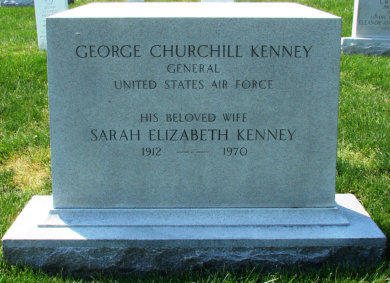Wartime Heritage
ASSOCIATION

George Churchill Kenney
Date of Birth:
August 6, 1889
Place of Birth:
Yarmouth, Nova Scotia
George Churchill Kenney was born in Yarmouth, Nova
Scotia, Canada, during a summer vacation taken by
his parents. He was the oldest of four children. His
parents were Joseph Atwood Kenney, a carpenter,
and Anne Louise (Churchill) Kenney. He grew up in
Brookline, Massachusetts. He graduated from
Brookline High School in 1907 and later that year he
entered the Massachusetts Institute of Technology,
where he studied civil engineering. He went on to
take various jobs before joining the Quebec
Saguenay Railroad as a surveyor.
George Kenney returned to Boston in 1913, where he
took a job with Stone & Webster. In 1914 he joined
the New York, New Haven and Hartford Railroad as a
civil engineer. He went on to form an engineering
partnership with a high school classmate in
Massachusetts.
After the United States entrance in the First World
War in April 1917, Kenney enlisted as a flying cadet
in the Aviation Section, U.S. Signal Corps on June 2,
1917. He attended ground school at MIT in June and July, and received primary flight training at Hazelhurst Field in
Mineola, New York, from Bert Acosta. He was commissioned as a first lieutenant on November 5, 1917, and
departed for France soon after for Advanced Flying Training School. There, he received further flight training at
Issoudun. In February 1918, upon successful completion of the course, he was assigned to the 91st Aero Squadron.
The 91st Aero Squadron flew the Salmson 2A2, a reconnaissance biplane. Kenney crashed one on takeoff on March
22, 1918. He broke an ankle and a hand, and earned himself the nickname "Bust 'em up George". His first mission
was undertaken on June 3, having recovered from his injuries.
Kenney flew one of four aircraft on a mission near Gorze on 15 September 1918 that was attacked by six German
Pfalz D.III scouts. His observer shot one of them down, and Kenney was credited with his first aerial victory. For this
he was awarded a Silver Star. A second victory followed in similar circumstances on October 9th while he was flying
near Jametz in support of the Meuse-Argonne Offensive. Once again, the formation he was flying with was attacked
by German fighters. This time he was awarded the Distinguished Service Cross, which was presented by Brigadier
General Billy Mitchell on 10 January 10, 1919. Kenney's citation read:
“For extraordinary heroism in action near Jametz, France, October 9, 1918. This officer gave proof of
his bravery and devotion to duty when he was attacked by a superior number of aircraft. He accepted
combat, destroyed one plane and drove the others off. Notwithstanding that the enemy returned and
attacked again in strong numbers, he continued his mission and enabled his observer to secure
information of great military value.”
As World War I ended, Kenney remained for a time with the Allied occupation forces in Germany, and was promoted
to captain on March 18, 1919. He returned to the United States in June 1919 and was sent to Kelly Field, near San
Antonio, Texas, and then to McAllen, Texas. As commander of the 8th Aero Squadron, he flew reconnaissance
missions along the border with Mexico during the Mexican Revolution.
During World War II, he was given command of Allied Air Forces in the Southwest Pacific in September 1942
Lieutenant General Kenney, in command of American Air Forces in the Southwest Pacific, directed one of the most
decisive operations of World War II in the crushing defeat of a twenty-two ship Japanese convoy off the coast of
New Guinea.
Lieutenant General Henry H. Arnold, Commanding General Army Air Forces, in a statement said, “In attacking and
eliminating the enemy were he was most vulnerable and before he had time to get set, General Kenney utilized the
striking power of his air force to the fullest advantage. The bomber crews and fighter pilots who disregarded bad
weather and comparatively close enemy air bases carried out their missions in the highest traditions of the Air
Forces.”
He wrote several books about his experiences during World War II, including "General Kenney Reports" (1949), a
personal history of the air war he led from 1942 to 1945, "The Saga of Pappy Gunn" (1959), and "Dick Bong: Ace of
Aces" (1960), which described the careers of Paul Gunn and Richard Bong, two of the most prominent airmen under
his command. In 1954 he became president of the Air Force Association and in 1958 he appeared as the host of the
television anthology series "Flight." He died at the age of 88.
Date of Death:
August 9, 1977
Place of Death:
Bay Harbor Islands, Florida, United States
Cemetery:
Woodlawn Park North Cemetery & Mausoleum Miami,
Miami-Dade County, Florida
Grave:
Mausoleum, Unit 9 Corridor 3 Section 13 Couch Crypt A
He is also memorialised on the headstone at the
Arlington National Cemetery, Virginia, USA, where
his wife Sarah Elizabeth Kenney is interred.
Sources:
https://en.wikipedia.org/wiki/George_Kenney
http://usafflagranks.com/Major_General_Clements_McMullen.htm
findagrave.com

copyright © Wartime Heritage Association
Website hosting courtesy of Register.com - a web.com company
Lieutenant General George Churchill Kenney




- World War I - Menu
- WWI Stories and Articles
- Photos - Yarmouth Soldiers
- Selection of World War I Songs
- WWI Casualties of Yarmouth, NS
- Those Who Served - Yarmouth, NS
- WWI Casualties Digby Co. NS
- WWI Casualties Shelburne Co. NS
- Merchant Mariners (1915) Yarmouth, NS
- Canadian Forestry Corps - Non Yarmouth Birth/Residence Enlistments
- US Draft Registry - Yarmouth NS Born


- World War II - Menu
- WWII Stories and Articles
- Telegraphist Air Gunners
- WWII Casualties of Nova Scotia
- US Casualties with NS Connection
- Far East/Pacific Casualties with NS Connection
- Merchant Navy Casualties Nova Scotia
- Nova Scotia WWII Casualties Holten Canadian War Cemetery
- D-Day Casualties - Nova Scotia
- CANLOAN Program Casualties - Nova Scotia
- Battle of the Bulge Casualties - Nova Scotia
- WWII Casualties Yarmouth NS
- Yarmouth Casualties - RCAF RAF Canadian Army WWII
- Yarmouth Co., Marrages WWII
- Casualties Non-Born/Residents with Connection to Yarmouth Co., Nova Scotia.
- WWII Casualties Digby Co., NS
- Non-Nova Scotian WWII Casualties Buried in Nova Scotia
- WWII RCAF Casualties Aged 16-18
- Brothers/Sisters Who Served - World War II













